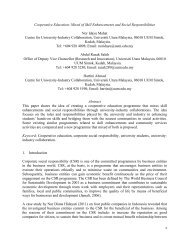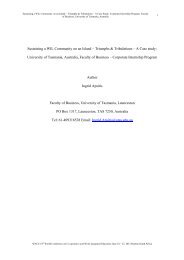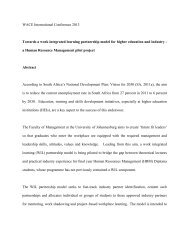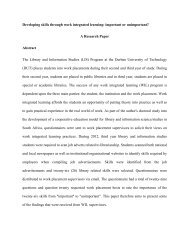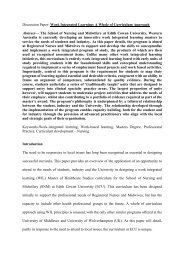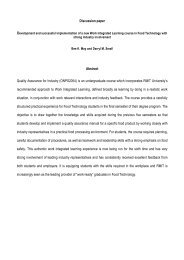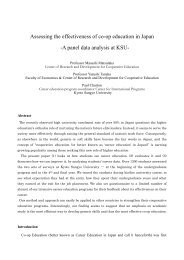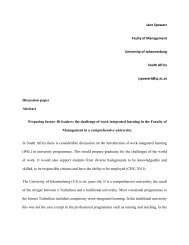Project based learning in distance mode.pdf - WACE
Project based learning in distance mode.pdf - WACE
Project based learning in distance mode.pdf - WACE
Create successful ePaper yourself
Turn your PDF publications into a flip-book with our unique Google optimized e-Paper software.
<strong>Project</strong> <strong>based</strong> <strong>learn<strong>in</strong>g</strong> <strong>in</strong> <strong>distance</strong> <strong>mode</strong>: Challenges<br />
and triumphs of onl<strong>in</strong>e eng<strong>in</strong>eer<strong>in</strong>g student teams<br />
Dr Fae Mart<strong>in</strong><br />
Central Queensland University, Mackay, Australia<br />
f.mart<strong>in</strong>@cqu.edu.au<br />
Ian Devenish<br />
Central Queensland University, Rockhampton, Australia<br />
i.devenish@cqu.edu.au<br />
Abstract<br />
Us<strong>in</strong>g project <strong>based</strong> <strong>learn<strong>in</strong>g</strong> (PBL) for eng<strong>in</strong>eer<strong>in</strong>g education allows students to learn<br />
both generic and technical skills <strong>in</strong> the context of eng<strong>in</strong>eer<strong>in</strong>g team projects. Central<br />
Queensland University (CQU) has been us<strong>in</strong>g the PBL <strong>mode</strong>l across the entire Bachelor<br />
of Eng<strong>in</strong>eer<strong>in</strong>g (BEng) program s<strong>in</strong>ce 1998 for on-campus students. Dur<strong>in</strong>g the same<br />
period CQU also offered programs at eng<strong>in</strong>eer<strong>in</strong>g technologist level for <strong>distance</strong> students<br />
however this program did not use PBL as its guid<strong>in</strong>g philosophy.<br />
In a review of the eng<strong>in</strong>eer<strong>in</strong>g programs <strong>in</strong> 2006 it was decided that the BEng offer<strong>in</strong>g<br />
would be extended to <strong>in</strong>clude <strong>distance</strong> students. Offer<strong>in</strong>g BEng by <strong>distance</strong> enables the<br />
<strong>in</strong>creas<strong>in</strong>g number of potential students who are unable to attend <strong>in</strong>ternal classes due to<br />
work commitments or remote location to become professional eng<strong>in</strong>eers. The challenge<br />
therefore was to provide a program of study that met the needs of mature students, most<br />
of whom would be work<strong>in</strong>g <strong>in</strong> <strong>in</strong>dustry, as well as school leavers. The ability to<br />
acknowledge an <strong>in</strong>dividual student’s background knowledge and life experience while<br />
giv<strong>in</strong>g them the opportunity to develop their weaker skills was seen as an asset of the<br />
1
PBL approach. However requir<strong>in</strong>g teamwork onl<strong>in</strong>e would <strong>in</strong>troduce additional<br />
complexities. This paper expla<strong>in</strong>s the strategies that were used to ensure that all students<br />
were given opportunities to meet the <strong>learn<strong>in</strong>g</strong> outcomes of the first PBL course offered <strong>in</strong><br />
both <strong>in</strong>ternal and <strong>distance</strong> <strong>mode</strong>. This first trial has been very successful result<strong>in</strong>g <strong>in</strong> a<br />
high rate of student retention and possible reasons for this success are discussed.<br />
Keywords<br />
Distance, eng<strong>in</strong>eer<strong>in</strong>g, external, onl<strong>in</strong>e, PBL, project, teamwork<br />
Introduction<br />
<strong>Project</strong> <strong>based</strong> <strong>learn<strong>in</strong>g</strong> (PBL) is a learner-centric pedagogy where the learner is expected<br />
to take responsibility for their own <strong>learn<strong>in</strong>g</strong>. Students work <strong>in</strong> teams on projects that<br />
provide a context for the <strong>learn<strong>in</strong>g</strong>. The PBL philosophy has been used by Central<br />
Queensland University (CQU) as the dom<strong>in</strong>ant educational paradigm <strong>in</strong> the professional<br />
Bachelor of Eng<strong>in</strong>eer<strong>in</strong>g (BEng) program s<strong>in</strong>ce 1998. However this program was only<br />
available to <strong>in</strong>ternal students.<br />
Dur<strong>in</strong>g the same time period, CQU offered the Bachelor of Eng<strong>in</strong>eer<strong>in</strong>g Technology<br />
(BEngTech) <strong>in</strong> <strong>distance</strong> <strong>mode</strong>. The teach<strong>in</strong>g materials for this program were mailed out<br />
to students <strong>in</strong> hardcopy. Students <strong>in</strong>teracted with their lecturer us<strong>in</strong>g email or telephone.<br />
The teach<strong>in</strong>g paradigm for the courses <strong>in</strong> this program was predom<strong>in</strong>antly a traditional<br />
approach with students work<strong>in</strong>g <strong>in</strong>dividually through the provided teach<strong>in</strong>g materials and<br />
hav<strong>in</strong>g m<strong>in</strong>imal <strong>in</strong>teraction with other students <strong>in</strong> the course.<br />
2
In response to the need for greater flexibility <strong>in</strong> eng<strong>in</strong>eer<strong>in</strong>g program offer<strong>in</strong>gs, <strong>in</strong> a<br />
review of the eng<strong>in</strong>eer<strong>in</strong>g programs <strong>in</strong> 2006 the decision was taken to extend the offer<strong>in</strong>g<br />
of the BEng to <strong>distance</strong> <strong>mode</strong>. The PBL philosophy was seen as an essential component<br />
of the BEng and therefore it would be necessary to offer the PBL courses for both<br />
<strong>in</strong>ternal and external students.<br />
This paper will discuss some of the challenges that the offer<strong>in</strong>g of a first year PBL<br />
eng<strong>in</strong>eer<strong>in</strong>g course <strong>in</strong> <strong>distance</strong> <strong>mode</strong> provided and also some of the benefits of PBL for<br />
<strong>distance</strong> students.<br />
PBL <strong>in</strong> CQU eng<strong>in</strong>eer<strong>in</strong>g program<br />
In 1993 the CQU Eng<strong>in</strong>eer<strong>in</strong>g Faculty made the decision to extend the professional<br />
eng<strong>in</strong>eer<strong>in</strong>g program to <strong>in</strong>clude <strong>in</strong>dustry work placements as an <strong>in</strong>tegrated part of the<br />
degree. The first offer<strong>in</strong>g of the CQU Bachelor of Eng<strong>in</strong>eer<strong>in</strong>g (Coop) was <strong>in</strong> 1994 with<br />
the first student work placements occurr<strong>in</strong>g <strong>in</strong> 1996. The students go<strong>in</strong>g on work<br />
placement were at the beg<strong>in</strong>n<strong>in</strong>g of their third year of study and early comments from<br />
employers <strong>in</strong>dicated they were ill-prepared for the workplace. In fact employers had been<br />
say<strong>in</strong>g the same th<strong>in</strong>g about graduate eng<strong>in</strong>eers across Australia as was reported <strong>in</strong> the<br />
Chang<strong>in</strong>g the culture report released by the peak Australian eng<strong>in</strong>eer<strong>in</strong>g body Institution<br />
of Eng<strong>in</strong>eers released <strong>in</strong> the same year (IEAust, 1996). In response to these concerns<br />
research <strong>in</strong>to possible ways of <strong>in</strong>creas<strong>in</strong>g the work read<strong>in</strong>ess of the students was<br />
undertaken and PBL was proposed as an educational paradigm that could improve these<br />
outcomes.<br />
3
The PBL approach was seen to be especially appropriate as it had been shown that the<br />
generic skills such as problem solv<strong>in</strong>g, communication and teamwork are well developed<br />
by PBL (Wolfs, Howard, Vann and Edwards, 1997). The team projects <strong>in</strong> PBL have a<br />
contextual focus enabl<strong>in</strong>g students to understand why they are <strong>learn<strong>in</strong>g</strong> the particular<br />
content and how it will be applied <strong>in</strong> the ‘real world’.<br />
The challenges of <strong>distance</strong> delivery<br />
CQU has been offer<strong>in</strong>g programs by <strong>distance</strong> <strong>mode</strong> s<strong>in</strong>ce the late 1990’s. However the<br />
programs available <strong>in</strong> this <strong>mode</strong> have been eng<strong>in</strong>eer<strong>in</strong>g technology level and did not use<br />
the PBL philosophy. The <strong>mode</strong> of delivery for most of these external courses <strong>in</strong>volved<br />
provision of a Course Profile that <strong>in</strong>cluded details of the course Learn<strong>in</strong>g Outcomes and<br />
assessment and a hard-copy Study Guide that covered the course content. The student<br />
received these materials at the beg<strong>in</strong>n<strong>in</strong>g of the term then worked through the material<br />
throughout the term accord<strong>in</strong>g to a schedule outl<strong>in</strong>ed <strong>in</strong> the Course Profile. Generally<br />
assessment items were submitted by post at set times dur<strong>in</strong>g the term.<br />
This form of delivery was immediately seen as <strong>in</strong>compatible with the PBL philosophy. In<br />
PBL, students should recognise the need to learn particular content as they work their<br />
way through the project. Rather than present<strong>in</strong>g course material <strong>in</strong> preparation for<br />
assessment, PBL requires the student to identify their own <strong>learn<strong>in</strong>g</strong> needs. Present<strong>in</strong>g<br />
students with a package of <strong>learn<strong>in</strong>g</strong> materials at the beg<strong>in</strong>n<strong>in</strong>g of the term is completely at<br />
odds with this. A new approach to external delivery was therefore seen as essential.<br />
4
Previous research has shown that the <strong>learn<strong>in</strong>g</strong> experiences of <strong>in</strong>ternal and external<br />
students are very different. Keegan (1986) lists the major contrasts <strong>in</strong> the two <strong>learn<strong>in</strong>g</strong><br />
styles <strong>in</strong>clud<strong>in</strong>g the fact that <strong>in</strong> face-to-face delivery students may have relatively low<br />
<strong>in</strong>ternal motivation while <strong>distance</strong> students are more likely to have high <strong>in</strong>ternal<br />
motivation. On the other hand, the <strong>distance</strong> student must communicate through media<br />
while the <strong>in</strong>ternal student has immediate, personal contact with their teacher. A recent<br />
study by Mir and Rahaman (2007) considered the difference <strong>in</strong> student outcomes between<br />
<strong>in</strong>ternal and external students for <strong>in</strong>stitutions where <strong>in</strong>tegrated courses are offered i.e.<br />
where both <strong>in</strong>ternal and external students study the same course. After gather<strong>in</strong>g data<br />
from 6 Australian universities, they suggested that the performance of external students is<br />
significantly <strong>in</strong>ferior to <strong>in</strong>ternal students study<strong>in</strong>g the same course. One of their<br />
recommendations is that more time could be spent <strong>in</strong> residential schools for external<br />
students particularly <strong>in</strong> their first year.<br />
Lawless and Richardson (2002) adm<strong>in</strong>istered two surveys to large samples of external<br />
students of the Open University. One survey focused on whether a particular student was<br />
mean<strong>in</strong>g oriented or reproduction oriented <strong>in</strong> their approach to study. A student who was<br />
mean<strong>in</strong>g oriented was characterised by a deep approach to <strong>learn<strong>in</strong>g</strong>, <strong>in</strong>terrelat<strong>in</strong>g ideas,<br />
relat<strong>in</strong>g evidence to conclusions and the ability to th<strong>in</strong>k creatively. A reproduction<br />
oriented student on the other hand was characterised as hav<strong>in</strong>g a surface approach to<br />
<strong>learn<strong>in</strong>g</strong>, rely<strong>in</strong>g on the teach<strong>in</strong>g staff to def<strong>in</strong>e <strong>learn<strong>in</strong>g</strong> tasks. The second survey was<br />
<strong>in</strong>tended to be an <strong>in</strong>dicator of teach<strong>in</strong>g quality. Questions on this survey related to<br />
whether students perceived the assessment and workload were appropriate, if they felt the<br />
5
course helped them develop their generic skills and if the materials and staff support were<br />
good. Comparison of the results of the two surveys showed that the mean<strong>in</strong>g oriented<br />
students were more satisfied with all aspects of the course (<strong>in</strong>clud<strong>in</strong>g overall satisfaction)<br />
than the reproduction oriented students suggest<strong>in</strong>g that student perception of the quality<br />
of their academic experience is <strong>in</strong>fluenced by their approach to their <strong>learn<strong>in</strong>g</strong>.<br />
One possible <strong>in</strong>ference from this research was that the PBL paradigm, because it<br />
encourages students to be mean<strong>in</strong>g oriented and take responsibility for their own<br />
<strong>learn<strong>in</strong>g</strong>, might result <strong>in</strong> better student outcomes for external students than traditional<br />
teach<strong>in</strong>g approaches.<br />
Eng<strong>in</strong>eer<strong>in</strong>g Skills 1 <strong>learn<strong>in</strong>g</strong> outcomes and assessment<br />
Eng<strong>in</strong>eer<strong>in</strong>g Skills 1 is the first course <strong>in</strong> the recommended schedule of study for all<br />
students <strong>in</strong> the professional eng<strong>in</strong>eer<strong>in</strong>g program and the new eng<strong>in</strong>eer<strong>in</strong>g technology<br />
program and is therefore the first course that most students <strong>in</strong> these programs study. The<br />
<strong>learn<strong>in</strong>g</strong> outcomes for the course are related to professional skills such as communication,<br />
teamwork, problem solv<strong>in</strong>g and ethics. Assessment for the course is 100% portfolio<br />
<strong>based</strong> (Jorgensen and Howard, 2005). Throughout the term, students work <strong>in</strong> teams on a<br />
succession of m<strong>in</strong>i projects. However these projects do not directly contribute to the<br />
summative assessment for the course. Instead they are simply a vehicle for the student<br />
<strong>learn<strong>in</strong>g</strong>. At the end of the term, each student submits an <strong>in</strong>dividual portfolio detail<strong>in</strong>g<br />
how they believe they have met the <strong>learn<strong>in</strong>g</strong> outcomes of the course and <strong>in</strong>clud<strong>in</strong>g<br />
evidence from the projects and workshops they have completed. An important part of the<br />
6
portfolio is the Individual Reflective Journal that each student keeps as a record of their<br />
<strong>learn<strong>in</strong>g</strong> dur<strong>in</strong>g the term.<br />
Students participate <strong>in</strong> four team projects throughout the term. The Design and build<br />
project gives students the opportunity to develop their problem-solv<strong>in</strong>g skills. Research<br />
skills are expanded <strong>in</strong> History of technology, Disassembly has a focus on materials<br />
application and Simulation / <strong>mode</strong>ll<strong>in</strong>g develops computer <strong>mode</strong>ll<strong>in</strong>g skills. As each<br />
project progresses, students are given the opportunity to attend lectures and workshops<br />
that are relevant to the project at hand.<br />
Offer<strong>in</strong>g Eng<strong>in</strong>eer<strong>in</strong>g Skills 1 for <strong>distance</strong> students<br />
It is assumed that <strong>in</strong> general, the demographics of external and <strong>in</strong>ternal students are very<br />
different. In the case of Eng<strong>in</strong>eer<strong>in</strong>g Skills the <strong>in</strong>ternal students are largely school leavers.<br />
For the 2007 cohort, the average age of <strong>in</strong>ternal students at the start of term was 19.2<br />
years. Compare this to the external students whose average age was 29.8 years. The<br />
external students were also widely dispersed geographically with more than 44% resid<strong>in</strong>g<br />
<strong>in</strong> areas more than 100km from the <strong>in</strong>ternal campuses <strong>in</strong>clud<strong>in</strong>g more than 8% resid<strong>in</strong>g <strong>in</strong><br />
another state. A typical first year <strong>in</strong>ternal student is a full-time student and although they<br />
may be employed part-time, their employment is not generally eng<strong>in</strong>eer<strong>in</strong>g-related.<br />
External students however may be apprentices (e.g. drafter, jeweller, electrician),<br />
tradespersons (e.g. electrician, fitter mach<strong>in</strong>ist), technicians and tra<strong>in</strong>ee eng<strong>in</strong>eers<br />
(mechanical designer, c<strong>in</strong>ema technician, construction foreman, process control<br />
technician), sales persons and bus<strong>in</strong>ess owners (earthmov<strong>in</strong>g, bus company).<br />
7
Residential school and team selection<br />
In l<strong>in</strong>e with the suggestions of Mir and Rahaman (2007), a compulsory one week<br />
residential school was scheduled for the first week of the teach<strong>in</strong>g term. This week had<br />
traditionally been deemed Induction Week for the <strong>in</strong>ternal students and had <strong>in</strong>cluded<br />
various team-build<strong>in</strong>g activities such as Ice-breakers and rock-climb<strong>in</strong>g (Mart<strong>in</strong>,<br />
Steedman, Smith and Keleher, 2006).<br />
A recurr<strong>in</strong>g feedback from external students is that they do not feel they are part of the<br />
university community. In order to go some way towards address<strong>in</strong>g this concern, dur<strong>in</strong>g<br />
the first few hours they were on campus the external students attended a welcome lecture<br />
with the <strong>in</strong>ternal students of the course and participated <strong>in</strong> the same team-build<strong>in</strong>g<br />
activities as the <strong>in</strong>ternal students. Dur<strong>in</strong>g the residential school, external students were<br />
<strong>in</strong>troduced to CQU processes <strong>in</strong>clud<strong>in</strong>g a session on where to f<strong>in</strong>d program/course<br />
<strong>in</strong>formation and staff contacts on the university website as well as an <strong>in</strong>troduction to the<br />
CQU on-l<strong>in</strong>e <strong>learn<strong>in</strong>g</strong> management system ‘Blackboard’. However the emphasis dur<strong>in</strong>g<br />
the residential school was on the team activities.<br />
Although creat<strong>in</strong>g teams consist<strong>in</strong>g of both <strong>in</strong>ternal and external students was orig<strong>in</strong>ally<br />
considered, this was dismissed due to the <strong>in</strong>herent difficulties associated with<br />
communication between the two cohorts. The <strong>in</strong>ternal students are ma<strong>in</strong>ly full-time<br />
students and therefore carry out the majority of their teamwork on weekdays. The<br />
external students on the other hand are mostly part-time students who work dur<strong>in</strong>g the<br />
day and may study nights or weekends.<br />
8
Team selection for the external students was largely <strong>based</strong> on postcode mak<strong>in</strong>g it possible<br />
for at least some team members to meet <strong>in</strong> person once the residential week was over.<br />
Dur<strong>in</strong>g the residential week the external teams participated <strong>in</strong> the rock-climb<strong>in</strong>g activity<br />
and had several teamwork sessions. The projects for the <strong>in</strong>ternal students are managed <strong>in</strong><br />
a very l<strong>in</strong>ear fashion with students hav<strong>in</strong>g clearly def<strong>in</strong>ed timeframes for each project and<br />
complet<strong>in</strong>g each project before they move on to the next. Dur<strong>in</strong>g Induction Week all the<br />
students work on an <strong>in</strong>troductory fun project but the external students were also given the<br />
first of the real projects and encouraged to complete as much of the project as possible.<br />
This was partly because the project was hands-on mak<strong>in</strong>g it more difficult to work on<br />
once the team was physically separated. However it had the added benefit of giv<strong>in</strong>g the<br />
external teams an opportunity to get ahead of the study schedule <strong>in</strong> case they encountered<br />
difficulties later <strong>in</strong> the term. The time-l<strong>in</strong>es for all the projects were made slightly more<br />
flexible for the external students <strong>in</strong> recognition of the fact that these students need to<br />
manage the demands of full-time work and family commitments <strong>in</strong> addition to their<br />
study.<br />
Feedback from the reflective journals and course feedback forum showed the external<br />
students appreciated the one week residential school at the commencement of the course.<br />
The residential school allowed students to work with team members to accelerate the<br />
completion of the course projects and provided students with an understand<strong>in</strong>g of their<br />
team members’ strengths and weaknesses.<br />
9
Onl<strong>in</strong>e support<br />
Once the residential school was over, the ma<strong>in</strong> course resource for the external students<br />
was the on-l<strong>in</strong>e ‘Blackboard’ course. CQU uses the Blackboard Academic Suite as an e-<br />
education platform for its <strong>distance</strong> courses. Each week the resources for that week were<br />
posted on the website. Internal students attended a one hour lecture each week. These<br />
lectures are generally quite <strong>in</strong>teractive with the facilitator ask<strong>in</strong>g questions of the students<br />
who are then expected to contribute to the discussion. The external students were able to<br />
view the slides for the lecture which <strong>in</strong>cluded the questions that have been asked or they<br />
could view the video-stream (<strong>in</strong>clud<strong>in</strong>g the slides) so that they could see the discussion<br />
that took place. All students were asked to reflect <strong>in</strong> their journal on the content delivered<br />
dur<strong>in</strong>g the lecture.<br />
The resource material for the weekly workshops was also posted on the website.<br />
However these resources had been designed to be used by the <strong>in</strong>ternal facilitator <strong>in</strong> an<br />
environment where additional explanation could be provided verbally and although some<br />
resources were redesigned to cater for the external students, more needed to be done <strong>in</strong><br />
order to clarify what was expected each week. In order to address this issue, a weekly<br />
email was sent to the external students outl<strong>in</strong><strong>in</strong>g the delivered content for that week,<br />
where the resources could be found on the website and also rem<strong>in</strong>d<strong>in</strong>g them of any<br />
approach<strong>in</strong>g deadl<strong>in</strong>es. This had the added benefit of ma<strong>in</strong>ta<strong>in</strong><strong>in</strong>g contact with the<br />
students on a regular basis which helped them feel they were a valued member of the<br />
cohort even if they were not physically attend<strong>in</strong>g class.<br />
10
Blackboard discussion boards were implemented that allowed student <strong>in</strong>teraction with<br />
lecturers and other students enrolled <strong>in</strong> the course. Where students directly emailed a<br />
lecturer with a query that would be relevant to other students, either the question /<br />
response would be placed on a discussion board or the student would be directed to ask<br />
the question on a discussion board.<br />
Discussion boards covered the themes of <strong>in</strong>teraction / knowledge of other students,<br />
<strong>in</strong>formation transfer, team <strong>in</strong>teraction and general course <strong>in</strong>formation. Initially, the<br />
ability for students to edit their comments was not allowed, however this restriction was<br />
lifted after students <strong>in</strong>dicated it was limit<strong>in</strong>g their will<strong>in</strong>gness to contribute if they could<br />
not correct errors they had made <strong>in</strong> their posts. At this time, anonymous posts were<br />
allowed, however no students chose to post <strong>in</strong> this manner.<br />
On the <strong>in</strong>teraction discussion board, students were required to post <strong>in</strong>formation regard<strong>in</strong>g<br />
their work, personal history and aspirations. This allowed students to build on the<br />
personal <strong>in</strong>teractions made dur<strong>in</strong>g <strong>in</strong>duction week. Student feedback <strong>in</strong>dicated this<br />
discussion board was useful <strong>in</strong> rem<strong>in</strong>d<strong>in</strong>g students of team member skills and help<strong>in</strong>g to<br />
build a stronger team understand<strong>in</strong>g.<br />
The <strong>in</strong>formation transfer discussion boards related to specific topics covered dur<strong>in</strong>g the<br />
course. While course content was provided via Blackboard through other channels, these<br />
discussion boards provided students with a forum to ask either general course questions<br />
or those on a specific topic e.g. MATLAB or AutoCAD. Students were encouraged to<br />
11
espond to questions from other students on these boards, especially <strong>in</strong> the specific topic<br />
forums where it was recognised that because of the work history of the students some<br />
already possessed the skills <strong>in</strong> these specific areas.<br />
Team <strong>in</strong>teraction discussion boards and file exchange areas were provided that were<br />
available only to members of the team. These were the most used areas of the discussion<br />
board allow<strong>in</strong>g students to work together on their team projects.<br />
General course <strong>in</strong>formation discussion boards provided a forum where students could ask<br />
questions relat<strong>in</strong>g to course procedure and provide feedback on the course. Students were<br />
made aware that anonymous posts were allowed on these boards, however no students<br />
posted anonymously.<br />
On all the discussion boards, students were made aware of the amount of feedback or<br />
monitor<strong>in</strong>g the board would be subject to. General discussion boards were monitored<br />
and responded to on a daily basis, while the team discussion boards were monitored but<br />
had m<strong>in</strong>imal lecturer <strong>in</strong>put.<br />
Audio-visual presentations<br />
One facet of the communication <strong>learn<strong>in</strong>g</strong> outcome that is particularly challeng<strong>in</strong>g <strong>in</strong><br />
<strong>distance</strong> <strong>mode</strong> is audio-visual presentation. Internal students are able to achieve this<br />
outcome by present<strong>in</strong>g the outcomes of their project work <strong>in</strong> class. For the external<br />
students this was managed by hav<strong>in</strong>g the teams provide <strong>in</strong>formation before the<br />
presentation date, and then us<strong>in</strong>g conference telephone calls to present and support their<br />
12
data. Similarly conference calls were at times <strong>in</strong>itiated by the student teams where verbal<br />
<strong>in</strong>teraction was deemed necessary by them.<br />
Results for external and <strong>in</strong>ternal cohorts<br />
Retention rates for Eng<strong>in</strong>eer<strong>in</strong>g Skills 1 have traditionally been quite high but of course<br />
there had previously only been <strong>in</strong>ternal students <strong>in</strong> the course. Data from 2005 and 2006<br />
shows that more than 85% of students who enrolled <strong>in</strong> Eng<strong>in</strong>eer<strong>in</strong>g Skills 1 cont<strong>in</strong>ued<br />
<strong>in</strong>to the second term PBL course (Mart<strong>in</strong>, Steedman, Smith and Keleher, 2006). However<br />
the difficulties of study<strong>in</strong>g externally have historically resulted <strong>in</strong> high attrition rates for<br />
<strong>distance</strong> students. An analysis of the 2007 enrolment data for Eng<strong>in</strong>eer<strong>in</strong>g Skills 1<br />
showed that 93% of <strong>in</strong>ternal students and 85% of external students enrolled <strong>in</strong> the<br />
subsequent course. These results are consistent with the <strong>in</strong>ternal attrition rates <strong>in</strong> previous<br />
years. It is believed that team peer pressure and the desire not to let the team down<br />
contributed to the retention dur<strong>in</strong>g the term. This conclusion was re<strong>in</strong>forced by anecdotal<br />
evidence from teams.<br />
Comparison of results for the two cohorts is shown <strong>in</strong> Figure 1. Note that the students<br />
designated as fail<strong>in</strong>g <strong>in</strong>clude those who were still enrolled several weeks <strong>in</strong>to the term but<br />
who later chose not to complete the course. These results show that the grades achieved<br />
by the external students were comparable with the <strong>in</strong>ternal students so it seems that the<br />
external students were not disadvantaged by the <strong>mode</strong> of study.<br />
13
Grades for external and <strong>in</strong>ternal students<br />
% of students<br />
50<br />
40<br />
30<br />
20<br />
10<br />
External<br />
Internal<br />
Total<br />
0<br />
HD D C P F<br />
Grade<br />
Figure 1. Grades for external and <strong>in</strong>ternal students 2007<br />
The student grades for this course as well as the high retention rates and anecdotal<br />
evidence of high student satisfaction with the course <strong>in</strong>dicate that the PBL philosophy is<br />
well suited to external delivery. It is not clear whether this is because PBL supports the<br />
development of <strong>in</strong>dependent, mean<strong>in</strong>g oriented students (Lawless and Richardson, 2002)<br />
or whether it is because of the <strong>in</strong>creased peer support that developed as a result of the<br />
team projects. However <strong>in</strong> either case, the student outcomes were very encourag<strong>in</strong>g.<br />
Conclusion<br />
From the outset it was realised that offer<strong>in</strong>g a PBL course such as Eng<strong>in</strong>eer<strong>in</strong>g Skills 1<br />
for <strong>distance</strong> students would require different teach<strong>in</strong>g and <strong>learn<strong>in</strong>g</strong> strategies to those that<br />
were employed for <strong>in</strong>ternal students. Ultimately both cohorts of students needed to be<br />
given <strong>learn<strong>in</strong>g</strong> opportunities that would enable them to demonstrate they had met the<br />
<strong>learn<strong>in</strong>g</strong> outcomes of the course. However it was recognised that these <strong>learn<strong>in</strong>g</strong><br />
opportunities did not have to be identical provided the outcomes were the same. The<br />
14
open-ended format of the PBL pedagogy and portfolio assessment proved to be assets<br />
when try<strong>in</strong>g to cater for the two quite different cohorts. Even the teamwork requirements<br />
which were <strong>in</strong>itially expected to be challeng<strong>in</strong>g for the external students eventually<br />
proved to have very positive consequences as the students formed strong team bonds that<br />
encouraged them to keep go<strong>in</strong>g when they were experienc<strong>in</strong>g difficulties.<br />
It should be noted that although the teams were kept the same throughout Eng<strong>in</strong>eer<strong>in</strong>g<br />
Skills 1 for the subsequent PBL course the student teams were changed around <strong>based</strong> on<br />
results and postcode. Students have only just completed the follow-on course and at the<br />
time of writ<strong>in</strong>g the grades have not been f<strong>in</strong>alised. However prelim<strong>in</strong>ary anecdotal<br />
evidence seems to suggest that this follow-on course has also been successful <strong>in</strong> terms of<br />
student outcomes.<br />
References<br />
IEAust (1996). Chang<strong>in</strong>g the Culture: Eng<strong>in</strong>eer<strong>in</strong>g Education <strong>in</strong>to the Future. Institution<br />
of Eng<strong>in</strong>eers, Australia, Canberra, Australia.<br />
Jorgensen, D & Howard, P (2005). Assessment for Practice Oriented Education. In<br />
<strong>WACE</strong> 2005 Conference Proceed<strong>in</strong>gs (732111). Boston: World Association for<br />
Cooperative Education.<br />
Keegan, D. (1986). The foundation of <strong>distance</strong> education. London: Croom Helm.<br />
15
Lawless, C. & Richardson, J. (2002). Approaches to study<strong>in</strong>g and perceptions of<br />
academic quality <strong>in</strong> <strong>distance</strong> education. Higher Education, 44, 257-282.<br />
Mart<strong>in</strong>, F., Steedman, M., Smith, K. & Keleher, P. (2006, December). The Importance of<br />
Induction and Orientation Activities for First Year Eng<strong>in</strong>eer<strong>in</strong>g Students. Paper presented<br />
at 17 th Annual Conference of the Australasian Association for Eng<strong>in</strong>eer<strong>in</strong>g Education,<br />
Auckland, New Zealand.<br />
Mir, M. Z. & Rahaman, A. S. (2007). Off the radar: The problem of <strong>distance</strong>-<strong>learn<strong>in</strong>g</strong> <strong>in</strong><br />
‘<strong>in</strong>tegrated’ degrees. Australian Universities Review, vol 49, No 1 & 2, pp. 39-47.<br />
Wolfs P. J., Howard, P., Vann, A. & Edwards, R. (1997). A response to the National<br />
Eng<strong>in</strong>eer<strong>in</strong>g Education Review, BE2001 - A project eng<strong>in</strong>eer<strong>in</strong>g degree. In Proceed<strong>in</strong>gs<br />
of the Third Bi-annual Conference of the Australian Problem Based Learn<strong>in</strong>g Network<br />
(pp. 674-681). Newcastle, New South Wales.<br />
16



